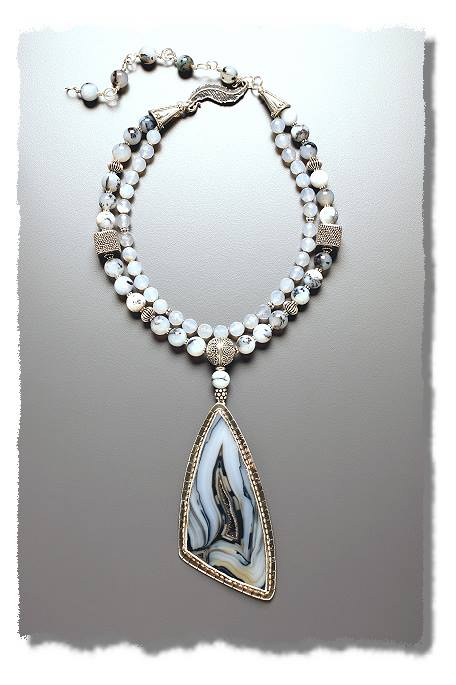This dramatic agate has an opening in the center filled with tiny crystals. I left the back of the bezel open to get as much light through the stone as possible. I feel relieved that this stone was not dyed some ghastly color but was left in its natural state.
Johann Zenz' Agates devotes 27 pages to the agates of Brazil. He tells a very interesting story: At the beginning of the 19th century, the agate deposits around the famed stone cutting center of Idar-Oberstein in Germany became depleted. Some enterprising individuals set off across the world to Brazil. As the story goes, in 1827 a group of German musicians, some of whom had worked as stone cutters, found a wall made entirely of agate at a farm near Soledade in southern Brazil. By 1834 the first rough had reached Idar-Oberstein. Since most of the goods traded between the old and new worlds came from the old world, the great sailing ships were desperate for ballast on the way back. What better ballast than agates?! The Brazilian agates are found in volcanic rocks from the Paraná basaltic group and form the largest known basalt flow on earth. The flow extends more than a million square kilometers and Zenz gives an estimated age of about 130 million years. Pabian and Jackson (see below) date them back to the late Permian (248 - 275 MYO). Whoever is correct, we can say with assurance that this gorgeous stone lay hidden in the earth for a very long time before it was brought to light and cut for your amazement and pleasure.
Curiously the Book of Stones does not have a separate section on Brazilian agate. They do mention that agate, with its lower intensity, is regarded as a stabilizing and strengthening influence. The agate is the 8th stone in the Breastplate of Aaron, signifying the tribe of Asher (Exodus 28:15-21). Diane Ackerman's poem in Within the Stone is a response to a banded agate and includes the line, "and the wavy strata of memories..." Dorion Sagan's little essay on another banded agate begins with the line, "Again I see that beauty has no mercy." If you love beautiful stones and fascinating meditations on them, I would urge you to have a look at this book!
I do hope you will order this beautiful necklace today and write your own meditations on this beautiful agate!



